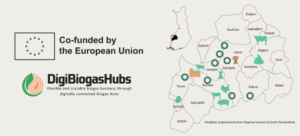South Ostrobothnia, Food system-based hub
CBG and LBG, Food system-based hub

In the South Ostrobothnia biogas hub, the most significant biogas potential is related to primary production and the food chain, such as large farms and the food industry. Nurmon Bioenergia’s biogas plant will bring a large-scale liquefied biogas (LBG) production facility to the region. A regional biogas ecosystem is also planned for Kurikka, based on large cattle and pig farms. The Lakeuden Etappi biogas plant in Ilmajoki will produce biogas and land improvement sludge from biowaste and sewage sludge. In addition, there are individual farms in South Ostrobothnia with biogas production for own use, for example in Vimpeli, Karijoki and Kurikka. Agricultural enterprises in the region therefore play an important role in the sale and production of biogas, as they generate the largest amount of biomass suitable for production.
In addition to cattle and pig farms in the region, heavy transport companies are key players, as the main potential users of biogas are heavy transport. Other potential users of biogas are the industrial plants in the region, with the food industry leading the way, following the example of Nurmon Bioenergia. There is also potential for the production of thermal energy in district heating.
The main arterial roads in the region in terms of biogas potential are:
- highway 16, which runs through the region from Ylistaro to Lapua and further to Alajärvi
- highway 19, which runs from Jalasjärvi in Kurikka through Seinäjoki, Lapua, and Kauhava
- highway 18, which leads from Ähtäri through Alavus and Seinäjoki toward Isokyrö
- highway 3, which runs from Jalasjärvi in Kurikka toward Vaasa
- main road 66, which runs from Alavus to Lapua
- main road 67, which runs from Ilmajoki to Seinäjoki
Regional cooperation enables the growth of the biogas business
The large-scale utilization of biogas requires a sufficiently large feedstock potential, including slurry, dry manure, and various fermentable by-products from crop farming, such as straw, different types of grass, and potato stalks, located within a reasonable distance from a potential plant.
Increasing biogas production requires collaboration between local businesses and potential biogas producers. Companies also need a willingness to invest in and commit to biogas, for example, in truck transport. Additionally, the recycling of digestate—the second end-product of biogas plants—back to fields as a fertilizer for food production must be addressed. Digestate is an excellent fertilizer for crop cultivation, partly due to its soluble nitrogen content.
For new plant investments, challenges include securing financing and ensuring functional ownership arrangements. In the region, there is potential to produce biogas from joint farm-based biogas plants (CBG/LBG). It is not economically viable for every farm to invest in its own plant; therefore, shared facilities between a few medium- and large-scale farms could serve as an incentive for investment in the biogas business. Due to structural changes, it is becoming profitable for more farms to produce biogas and sell it to local operators. However, selling upgraded gas from agricultural enterprises is highly capital-intensive, and the revenue from the sold gas is relatively small.
Two other biogas hubs produced in the DigiBiogasHubs project:
Further information


